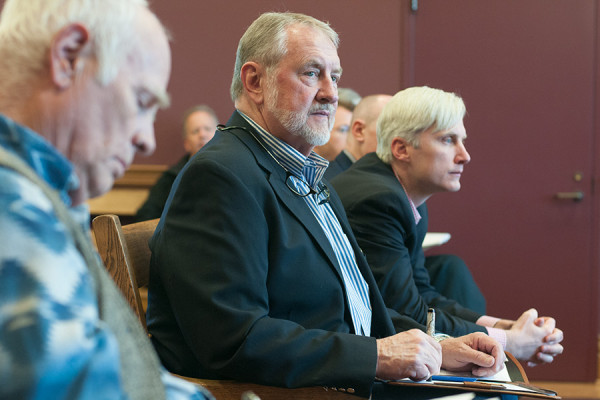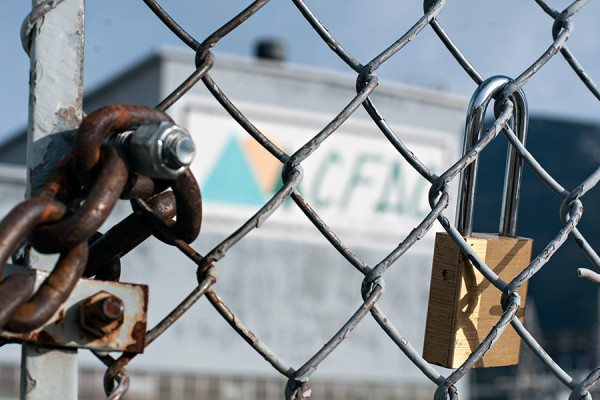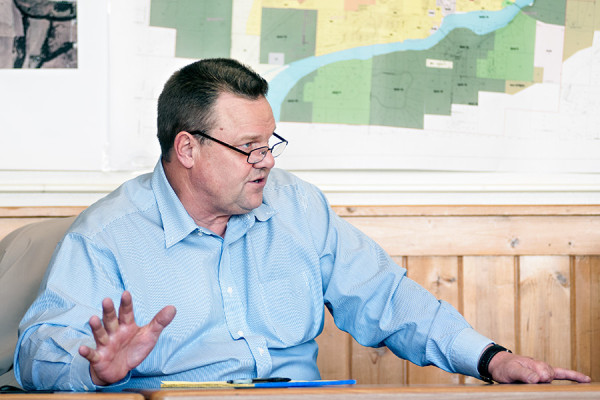Standing in an abandoned parking lot beneath the Columbia Falls Aluminum Co. plant’s blistered façade, the mural of an orange sun setting between two mountain prominences cast in faded relief against a bright Montana sky, it’s difficult to imagine the once-gleaming manufacturing facility humming with activity, a lifeblood to the community.
At its height, CFAC employed 1,500 workers, providing good-paying jobs and supporting generations of families in the region.
But recent news of the plant’s permanent closure, coupled with a proposal by the U.S. Environmental Protection Agency to list the contaminated site on the federal Superfund Program’s National Priorities List for environmental remediation, has dashed any lingering hopes of the plant reopening, a fate underscored by its visible state of disuse, the locked gates and blanched paint job a ghostly reminder of its former vitality.
And while the irrevocability of the news means the community can finally turn its attention to the site’s future and its potential as a home for purposes other than aluminum production, it has also rankled local officials, laid-off workers and state and federal lawmakers who for years worked tirelessly to strike a deal to reopen the mothballed facility – a deal, they say, that the company’s owners never intended to make good on.
They say the Swiss commodities giant Glencore, which bought CFAC in 1999, has for years made empty promises, stringing the community along with false assurances and no real intention of reopening, even as company officials were presented with deal after deal to reinvigorate the facility.
“In my opinion it was just a sham. I don’t think they ever intended to reopen,” said Dave Toavs, who worked for CFAC for 32 years and is president of the Aluminum Workers Trade Council, which continues to represent hundreds of laid-off hourly workers seeking severance pay. “I think the higher-ups shut it down and walked away. And what ticked me off is that they kept stringing us along, me and the company and the whole state, for years. And then they walked away.”

Glencore, the largest commodities trading group in the world, closed the CFAC aluminum plant along the Flathead River in 2009, citing high electricity rates and poor aluminum market conditions. Since then, a small handful of employees have remained on site to maintain the 800-acre facility, which sits on a 2,500-acre property at the base of Teakettle Mountain.
Meanwhile, hundreds of laid-off workers have clung to the hope that the plant might restart, or that the site would be repurposed to accommodate a new job-creating industry. At the very least, they were optimistic that negotiations for severance pay would come to fruition.
Now, with all avenues to reopen the plant exhausted and the likelihood of a drawn-out environmental cleanup in the works, an uncertain future lies ahead for the contaminated site.
The plant began producing aluminum in 1955, under ownership of the Anaconda Company and over the years grew into a major regional employer, peaking at around 1,500 employees and supporting the community with high-paying jobs.
After the Atlantic Richfield Company purchased the Anaconda Company in 1977, the aluminum market ran into a period of tumult and, in 1985, ARCO sold the plant to investors, led by Brack Duker. What followed was a period marked by a labor dispute culminating in a lawsuit and a $97 million settlement paid out to workers in 1998.
Beset by poor market conditions and rising electricity prices, CFAC resembled a hollow version of itself in the final years of the 1990s, even as the community held out hope that it would one day return to its heyday.
When Glencore purchased the plant, workers still clung to that hope, even as the workforce was curtailed, with the largest layoffs occurring between 2006 and 2009.
Brian Doyle, a former plant employee and president of the Steelworkers Local 320, was one of the last employees to be laid off, but never abandoned the hope that the plant would reopen.

In hindsight, he says his optimism was unfounded, likening it to the kind of wishful thinking that one employs when buying a lottery ticket, implausible as it is.
“Nobody thought it was going to shut down,” he said. “It’s a sad deal. My dad started here in 1955. I started here and I raised my family. And then I was one of the guys shutting the doors.”
“This is my life. This has been my life for 35 years,” Doyle added. “It’s just a shell of what it once was, but it was the livelihood for a lot of people for a lot of years. But to Glencore, we’re just a number. They don’t know who we are, and they don’t care.”
Working alongside Toavs and Doyle, U.S. Sen. Jon Tester and former U.S. Sen. Max Baucus tried for years to broker a power agreement with Bonneville Power Administration that would have allowed Glencore to restart the plant and put the laid-off employees back to work.
But Tester said any faith in Glencore’s intentions began to diminish when, time and time again, the company asked for and then rejected power agreements that would have allowed the plant to reopen.
“It was a sweet deal and BPA bent over backwards to try and accommodate Glencore. I put a lot of pressure on BPA to strike that deal,” Tester said. “I think the reason Glencore never accepted that deal is that they never had any intention of reopening CFAC because they had the opportunity to do business a lot cheaper overseas.”

Toavs recalls telling the laid-off workers that a potential deal had been reached, that it seemed likely the plant would restart, but then only to have Glencore reject it outright.
“When they turned that deal down it was a shock,” Toavs said. “Shoot, I spent over half my life out there and some of these guys had more invested in it than I did. It’s something that I don’t ever want to have to witness or experience again. It was a terrible thing to have happen and then for this company to string these workers on, it just ticked me off. I’m bitter. Because these people worked like crazy to keep this plant running.”
Doyle, too, recalls the crestfallen moment when he learned Glencore had rejected the power deal.
“Dave called me right before Christmas and I was positive we had that power contract in place, and then he called back one afternoon and said Glencore didn’t take it. I was just floored,” Doyle said.
Toavs and Doyle were scheduled to sit down at the table with a Glencore attorney for a final round of severance discussions on March 10, one day after the Beacon went to print, and said they hoped to arrange some compensation for the 250 laid-off hourly workers they collectively represent.
In an email, Glencore spokesperson Charles Watenphul declined to comment on the timing of the plant’s closure, which came one day before the EPA announced its decision to propose the site for Superfund listing. He also declined to add anything beyond what the company stated in a March 3 press release announcing the closure.
“While this decision marks the end of aluminum production in Montana, it also paves the way for the possibility of finding alternative uses for this strategic property,” company officials said in the press release. “The decision to permanently close was a difficult one, but after deep consideration, management is confident it is in the best interests of the community.”
This month, the EPA will propose adding the shuttered plant site to the federal Superfund Program’s National Priorities List, according to a letter the agency sent on March 4 to Gov. Steve Bullock.
Echoing concerns of local residents and lawmakers, both Bullock and Tester recently urged EPA officials to proceed with listing the site on the federal priority list and move forward with cleanup of the 2,500-acre site, located at the gateway to Glacier National Park.
“I’m concerned that if this issue remains unaddressed, the contamination from the site is serious enough to pose long-term risks to the community and to Montana’s environment, including the Flathead River,” Bullock stated in his letter.
On March 4, one day after officials announced the aluminum reduction plant was permanently closed, EPA Regional Administrator Shaun McGrath wrote Bullock that the agency would move forward with a proposed listing.
“I am pleased to report that we expect to propose the site for listing when the next NPL update is published in the Federal Register, currently scheduled for March 2015,” according to McGrath’s letter.
After the close of a 60-day comment period, the EPA will make a final listing decision after considering all comments received.
Bullock’s letter came just over a month after Tester penned a letter to EPA Administrator Gina McCarthy similarly pushing for a Superfund listing for CFAC.
Reports from the state DEQ and the EPA showed the site was eligible for Superfund status after potentially hazardous materials were discovered in soil, groundwater and surface water at the plant site, and cyanide contamination was found in sediment in the Flathead River, though CFAC officials have opposed listing.

Haley Beaudry, a spokesman for CFAC, said Superfund listing would devalue the property and unnecessarily delay the cleanup. Instead, he and other CFAC officials hoped to develop an independent remedial investigation work plan through a private environmental consulting firm, the New York-based Roux Associates.
“We are going to push for redevelopment of that site, however Superfund listing will delay redevelopment for a long time,” Beaudry said. “We don’t know how long. The Superfund law is 31 years old, and some Montana sites have been on the list for that entire time. I am 100 percent sure listing would compromise the prospects for redevelopment. And people don’t like to live next door to a Superfund site so the property around there in my opinion loses value.”
Bullock said that adding another Superfund site to Montana does not blight the state or the property, but rather demonstrates a commitment to environmental responsibility and maintaining Montana’s pristine quality.
“A state of 147,000 square miles where we have incredible natural beauty that draws people from all around the world, people who come here to enjoy our clean air and clean water, I don’t think another listing deters from that,” Bullock told the Beacon in a March 6 interview. “I think another listing underscores our real intent to make sure that we do maintain our clean air and clean water.”
According to the letter McGrath sent to Bullock, the EPA was sensitive to the community’s stake in the site, its cleanup and redevelopment, and support for a federal cleanup was evident at a series of public meetings held in late 2014.
“As the investigation continues, domestic wells will be sampled to better understand the potential risk to nearby residents in order to remedy any immediate concerns as well as to ensure the long-term cleanup will be protective,” McGrath wrote. “The EPA is committed to working cooperatively with the community, including the city of Columbia Falls, Flathead County and the site owners to ensure the cleanup will address the human health and environmental concerns while considering the site owner’s and the community’s redevelopment goals. Here, and in other communities, the EPA has been committed to alerting the community about upcoming contract opportunities and hiring local labor whenever possible.”
Glencore stated that as part of the closure it would demolish existing structures on the site. It added that it would comply with all rules and regulations to ensure the looming environmental cleanup was done safely.
“We look forward to working through this next chapter in as timely a manner as possible and helping bring new industry to Columbia Falls,” officials concluded in their statement.
The NPL is the list of national priorities among the known releases or threatened releases of hazardous substances, pollutants, or contaminants throughout the United States. It is used to guide the EPA in determining which sites warrant further investigation.
Tester said the Superfund listing could translate into jobs for workers once cleanup begins, though he admits that a long road lies ahead and that it won’t be accomplished “with a magic wand.”
Although it’s counterproductive to dwell on the past, the community of Columbia Falls and the laid-off workforce was “left holding the short end of the stick,” Tester said.
“It was a good business, a great business, and I think it could still be open today if that corporation had any will at all,” Tester said. “In the meantime those workers were left hanging out there on a string.”
